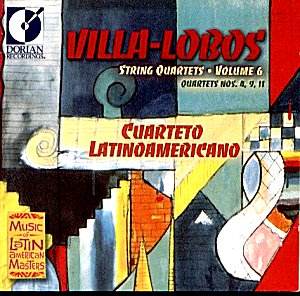This is the sixth and final volume in Dorian’s
impressive traversal of the complete Villa-Lobos quartets (all
seventeen of them). The astute mixing of compositional periods
is fruitfully maintained – the Fourth dates from 1917, the Eleventh
from 1948 – and there is as ever a huge amount of harmonic interest,
colour and rhythmic diversity to tempt the ear. On those few occasions
that I find the Latin American quartet lacking it’s mainly a matter
of tempo relation because otherwise they are commendable guides
to the corpus of work. In the opening Allegro con moto of the
Fourth I do find them too slow – though there is plenty of relaxed
dialogue between the four voices, an elegant conversational counterpoint
and a fine, increasingly impassioned coda, strong willed and dynamic.
The Andantino, subtitled tranquillo, is by contrast heat hazy,
with a fine exchange between viola and cello. Written in his favoured
ABA structures the piu mosso brings lissom and freewheeling fun
complete with bird cries and exotic figures in a predominately
brown hued landscape evoked by Villa-Lobos’s imaginative hand.
There are Debussy hints here as well in the frequently gorgeous
impressionism. For the scherzo he draws on a favourite device
– children’s song in a movement lightly and brightly scored and
in the finale there’s more impressively weighty viola sonority
and plenty of fugato development.
There’s a tough triplet start to the Ninth. It’s
quite sinewy and has a degree of atonality embedded in it; it
yields later to moments of lyricism but the writing remains rather
brittle and brisk. As one who thrives on contrast and juxtaposition,
it’s not at all surprising that he unfolds now an initially intensely
slow Andante Vagaroso. This is harmonically complex, introspective,
reflective, arching – with a faster central section – and a kind
of Bartókian tension. There are also little folk fiddle
insinuations. The Scherzo – actually a poco moderato with the
explicit instruction com bravura – is again tough. It’s
not as light, dextrous and aerated as most of the quartet scherzi
can be and usually are. But the finale is certainly up to scratch
– this is one of Villa-Lobos’s rhythmically driving movements,
dominated for large tracts by the first violin. There is, however,
an excellently frenetic coda, complete with dramatic, theatrical
end flourish.
The opening of the Eleventh is notable for the
juxtaposition of fragmentary units. There is in addition a strong
neo-classical spirit in the triumphalist unison writing creating
its own tension as well as an enhanced sense of colour and drama.
Some droning folk fiddles make their unmistakeable presence felt
in the second movement that breaks into a peasant dance of real
- if brief – vitality and Villa-Lobos reaches for his powerful
imitative writing in the Adagio. This is a curiously withdrawn
movement, melancholy and compelling. The finale is bright, infectious
but there’s also behind this a gimlet eye at work; the direction
is unerring and in the B section there’s some quietly uncompromising
writing. A master of contrast and colour.
I’ve reviewed all six in this series with real
pleasure and the enjoyment has continued here. The sensitivity
and understanding of the Latin American Quartet are palpable;
quibbles regarding under-the-tempo movements are minor; their
tonal profile is attractive and they are sane and good guides.
Jonathan Woolf
Other
reviews
Volume
1
Volume
2
Volume
3
Volume
4
Volume
5
Volume
6
